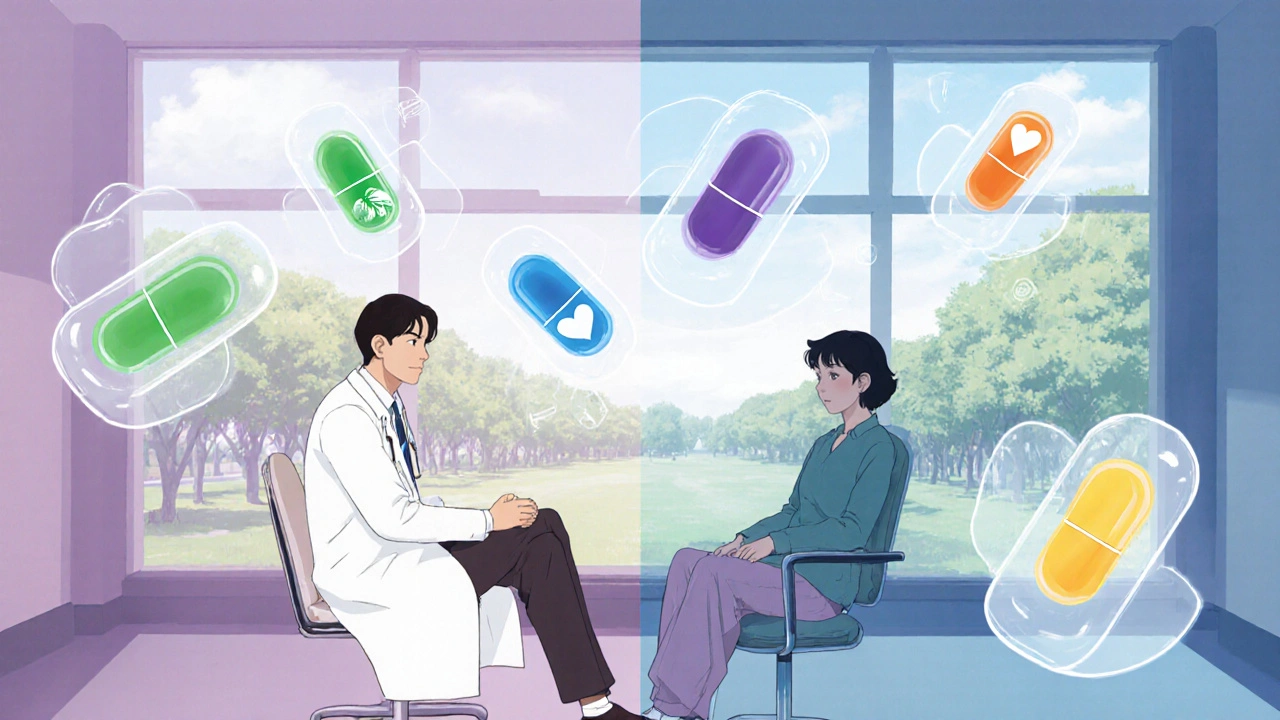Antidepressant Comparison Tool
Find Your Best Antidepressant Match
Answer a few questions to get personalized recommendations based on your symptoms, side effect tolerance, and other health considerations.
If you’ve been prescribed Elavil and are wondering whether another pill might suit you better, you’re not alone. Millions of people wrestle with the same question every year, especially when side effects start to feel like a second prescription. This guide breaks down what makes Amitriptyline tick, then lines it up against the most common alternatives so you can see which one fits your health goals.
What is Elavil (Amitriptyline)?
Amitriptyline is a tricyclic antidepressant (TCA) that was first introduced in the 1960s. It works by increasing the levels of norepinephrine and serotonin in the brain, two neurotransmitters that influence mood, pain perception, and sleep. In the UK it’s sold under the brand name Elavil, but the generic form is widely available worldwide.
How Amitriptyline Works
The drug blocks the reuptake of norepinephrine and serotonin, keeping them active longer at synaptic gaps. This boost helps correct the chemical imbalance that’s often linked with major depressive disorder. Beyond mood, the same mechanism dampens signals that trigger chronic pain, which is why doctors also prescribe it for neuropathic pain and migraine prevention.
When Is Amitriptyline Typically Prescribed?
- Major depressive disorder (particularly when other antidepressants have failed)
- Neuropathic pain caused by diabetes, shingles, or spinal injury
- Migraine prophylaxis
- Insomnia associated with depression
Because it hits both mood and pain pathways, Amitriptyline is a go‑to for patients who need a dual‑action drug.

Common Side Effects and Safety Notes
TCAs like Amitriptyline are effective but come with a side‑effect baggage that newer drugs often avoid. Typical complaints include dry mouth, constipation, blurred vision, weight gain, and drowsiness. At higher doses, you might notice cardiac rhythm changes or orthostatic hypotension.
Older adults should be especially cautious; the sedative effect can increase fall risk. The drug also interacts with many other medications, including MAO inhibitors, certain antihistamines, and some heart rhythm drugs. Always double‑check with your pharmacist.
Top Alternatives to Amitriptyline
Below are the most frequently switched‑to antidepressants. Each belongs to a different drug class, which means a distinct side‑effect profile and set of clinical strengths.
Sertraline - an SSRI
Sertraline (brand name Zoloft) is a selective serotonin reuptake inhibitor. It’s the first‑line choice for many types of depression and anxiety because it tends to cause fewer anticholinergic side effects than TCAs.
- Pros: Lower risk of weight gain, minimal sedation, widely studied for anxiety disorders.
- Cons: May cause sexual dysfunction, occasional gastrointestinal upset.
- Typical dose: 50-200 mg per day.
Venlafaxine - an SNRI
Venlafaxine (brand name Effexor) blocks the reuptake of both serotonin and norepinephrine, giving it a broader effect than an SSRI while staying out of the TCA family.
- Pros: Strong efficacy for severe depression, helps with certain chronic pain conditions.
- Cons: Can raise blood pressure at higher doses, may cause withdrawal symptoms if stopped abruptly.
- Typical dose: 75-375 mg per day.
Duloxetine - an SNRI
Duloxetine (brand name Cymbalta) is another serotonin‑noradrenaline reuptake inhibitor, approved for both depression and neuropathic pain.
- Pros: Treats depression and pain simultaneously, less sedating than TCAs.
- Cons: Can cause liver enzyme elevations; not ideal for patients with severe liver disease.
- Typical dose: 30-120 mg per day.
Mirtazapine - a NaSSA
Mirtazapine (brand name Remeron) works by antagonizing certain serotonin and histamine receptors, which often leads to improved sleep and appetite.
- Pros: Excellent for patients with insomnia or loss of appetite, low risk of sexual side effects.
- Cons: Notable weight gain, strong sedation especially at lower doses.
- Typical dose: 15-45 mg per day.
Citalopram - an SSRI
Citalopram (brand name Celexa) is a well‑tolerated SSRI that’s often chosen for its relatively mild side‑effect profile.
- Pros: Low incidence of weight gain, minimal anticholinergic effects.
- Cons: At doses >40 mg, it can prolong the QT interval, so cardiac monitoring may be needed.
- Typical dose: 20-40 mg per day.

Side‑by‑Side Comparison Table
| Drug | Class | Primary Uses | Typical Daily Dose | Weight‑Gain Risk | Sedation Level | Cost (UK, generic) |
|---|---|---|---|---|---|---|
| Amitriptyline | Tricyclic antidepressant | Depression, neuropathic pain, migraine prophylaxis | 25‑150 mg | High | High | ~£0.30 per tablet |
| Sertraline | SSRI | Depression, anxiety, OCD | 50‑200 mg | Low | Low‑moderate | ~£0.18 per tablet |
| Venlafaxine | SNRI | Severe depression, panic disorder | 75‑375 mg | Moderate | Low‑moderate | ~£0.25 per tablet |
| Duloxetine | SNRI | Depression, diabetic neuropathy, fibromyalgia | 30‑120 mg | Low‑moderate | Low | ~£0.28 per capsule |
| Mirtazapine | NaSSA | Depression with insomnia, appetite loss | 15‑45 mg | High | High | ~£0.22 per tablet |
| Citalopram | SSRI | Depression, anxiety | 20‑40 mg | Low | Low | ~£0.19 per tablet |
How to Choose the Right Medication
Switching from Amitriptyline isn’t a one‑size‑fits‑all decision. Here’s a quick checklist you can run through with your prescriber:
- Primary symptom focus: Is pain the main issue, or is mood the priority? TCAs shine for pain, while SSRIs are mood‑centric.
- Side‑effect tolerance: If weight gain and drowsiness are deal‑breakers, look to SSRIs or low‑sedation SNRIs.
- Drug interactions: Review any other meds you take. TCAs have the most interactions; SSRIs are comparatively cleaner.
- Medical history: Heart disease, liver issues, or seizure disorders can rule out certain drugs.
- Cost and availability: Generic SSRIs and SNRIs are cheap in the UK, while newer branded options may be pricier.
Write down your answers and discuss them openly with your doctor. A clear rationale speeds up the taper‑and‑switch process and reduces the chance of withdrawal symptoms.
Frequently Asked Questions
Can I stop Amitriptyline abruptly?
No. TCAs have a long half‑life and can cause rebound depression or withdrawal symptoms if stopped suddenly. A gradual taper, usually decreasing the dose by 10‑25 mg every one to two weeks, is recommended under medical supervision.
Is Amitriptyline safe for pregnancy?
Amitriptyline is classified as Category C in the UK, meaning risk cannot be ruled out. It’s generally avoided unless the benefit clearly outweighs the potential risk.
How long does it take for alternatives like Sertraline to work?
Most patients notice mood improvement within 2‑4 weeks, but full therapeutic effect may take up to 8‑12 weeks. Patience and regular follow‑up are key.
Will switching to an SNRI improve my neuropathic pain?
Both Venlafaxine and Duloxetine have strong evidence for neuropathic pain relief. Duloxetine is officially approved for diabetic peripheral neuropathy, making it a solid first choice.
Is weight gain inevitable with Amitriptyline?
Weight gain is a common side effect, but not everyone experiences it. Adjusting the dose, timing (taking it at night), or switching to a lower‑weight‑gain alternative can mitigate the issue.
Can I combine Amitriptyline with a newer antidepressant?
Combining two antidepressants is generally discouraged due to serotonin syndrome risk, unless under specialist care. It’s safer to switch fully before starting the new drug.
Armed with these facts, you can have a focused conversation with your healthcare provider and move toward a medication that matches your lifestyle and health needs.


Comments (4)
Jordan Levine October 24 2025
Listen up, folks – the drama around Amitriptyline side effects is overblown 🙄! This tricyclic packs a punch that can knock out both depression and neuropathic pain in one go. Sure, you might get dry mouth or drowsiness, but that's the price of power. If you can handle the sedation, you’re already winning the battle. So stop whining and give it a fair shot!
Michelle Capes November 6 2025
i totally get how tuff it can be to deal with weight gain and that groggy feeling 😞. many people dont realize the dose timing can help – taking it at night often eases the drowsiness. also, keep a food diary to spot any subtle changes in appetite. remember, you'r not alone in this struggle!
Doreen Collins November 19 2025
Alright, let’s break this down step by step. First, assess what’s dragging you down the most – pain or mood? If pain is the main villain, Amitriline’s dual action might still be your best ally. If mood swings dominate, consider tapering while introducing an SSRI like sertraline. Keep a symptom journal throughout the switch; it’ll give you concrete data for your doctor. Also, stay hydrated to combat dry mouth, and use a humidifier if nighttime cough shows up. Remember, consistency is key, and small tweaks can lead to big gains. You’ve got this, and every adjustment brings you closer to stability.
Amanda Vallery December 1 2025
Amitriptyline inhibits the reuptake of norepinephrine and serotonin, boosting their synaptic concentration. Its anticholinergic profile accounts for many of the classic side effects like dry mouth and constipation.